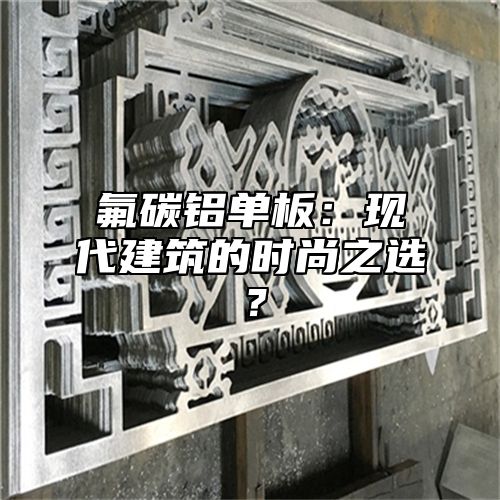

 Industry information
Industry information
Speaking of building materials, there is a guy called "fluorocarbon aluminum veneer" who has been quite popular in the construction industry recently. Perhaps you have already seen it on a tall building, its shiny appearance is really eye-catching. Let's talk about this seemingly trendy material. Is it the fashionable choice for modern architecture?
It has to be said that the name fluorocarbon aluminum veneer sounds quite high-end. It is actually a sheet made of aluminum alloy, and after special fluorocarbon coating treatment, the surface presents a glossy effect. Imagine the sunlight shining on it, reflecting dazzling lights one after another. Does it feel like the entire building comes to life?
In my personal opinion, the biggest advantage of fluorocarbon aluminum veneer is its weather resistance. No matter the wind or rain, it can maintain its shine. Unlike some materials, which become ashen after a long time, fluorocarbon aluminum veneer is simply a small expert in anti-aging. It can also resist the damage of acid rain and ultraviolet radiation, which is good news for those of us living in cities with severe environmental pollution.
Let's talk about its application scenarios again. I have seen the application of fluorocarbon aluminum veneer in a large commercial complex project before, and the effect was simply amazing! The appearance of the building has instantly improved by several levels, making people feel high-end and atmospheric at first glance. The installation of this type of board is also very convenient, unlike some traditional materials, which have a long construction period and are prone to problems. Once fluorocarbon aluminum veneer is installed on the wall, it becomes as stable as an old dog, without worrying about maintenance issues in the future.
Everything has two sides. Some people may say that the cost of fluorocarbon aluminum veneer is relatively high. Indeed, compared to traditional materials, its price may be higher. However, I don't think this is absolute either. After all, you get what you pay for, and good materials are naturally expensive. In the long run, the service life and maintenance cost of fluorocarbon aluminum veneer are lower than traditional materials, which is actually quite cost-effective.
Moreover, the design flexibility of fluorocarbon aluminum veneer is also very strong. You can customize various shapes and colors of panels according to the characteristics and needs of the building. In this way, the personalization and creativity of architecture can be fully displayed, which is exactly what modern architecture pursues?
However, I also have to share my small concern. Although fluorocarbon aluminum veneer has good weather resistance, will it encounter problems due to large temperature differences in extreme weather conditions, such as the cold winter in the north? I think this issue needs further observation and verification in practical applications.
Speaking of which, I couldn't help but recall my own experience of renovating a house. At that time, I was also attracted by the fashion sense and practicality of this material. Although the family's budget was limited at the time, they ultimately chose another material. Now thinking about it, if we had chosen fluorocarbon aluminum veneer at that time, the appearance of the house might have been even more outstanding.
Fluorocarbon aluminum veneer, as a new material in modern architecture, has its unique advantages and disadvantages. I personally think that it is indeed a fashionable choice, but when choosing, we still have to decide based on our own needs and budget. After all, what suits oneself is the best.
I would like to ask, have you ever seen fluorocarbon aluminum veneer on a certain building? What do you think of it? Welcome to share your opinions in the comment section! 😉